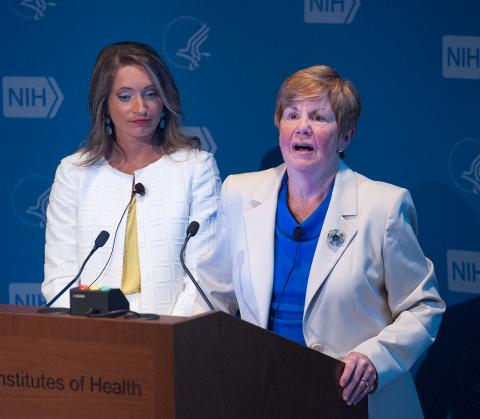Along the Gut-Brain Axis
Alcohol, Sleep and the Microbiome

Photo: Marleen Van Den Neste
Many people who regularly drink large amounts of alcohol have chronic sleep problems. By learning about the composition of the bacteria and other single-celled organisms in their digestive systems, researchers in the Clinical Center hope to develop treatments to help these patients sleep, said Dr. Alyssa Brooks during a recent Clinical Center Grand Rounds lecture in Lipsett Amphitheater.
“Alcohol affects sleep,” said Brooks, scientific program specialist in the CC’s nursing department. “The relationship between the two constructs is complex and alcohol can accelerate the onset of sleep, but disrupt sleep later in the night.”
Not getting the recommended 7 or more hours of sleep per night can lead to long-term health problems and dangerous behavior such as drowsy driving, she said.
People with alcohol use disorders (AUD) experience sleep disturbances throughout the night. They take longer to fall asleep than people who drink only occasionally or not at all. AUD is a condition where a person drinks alcohol compulsively, cannot control how much he or she drinks and feels anxious, irritable or stressed when sober.
Heavy alcohol use also affects a person’s microbiome, which refers to “the genome of all microorganisms within humans.” Much of a person’s microbiome is located in the gut. Diet, age, environment and medications influence the microbiome’s makeup.

Photo: Marleen Van Den Neste
Patients who consume alcohol chronically have a significantly different microbiome compared to healthy populations. These changes are associated with depression and alcohol craving that can eventually lead to relapse.
“We now understand there’s what we call the gut-brain axis,” Brooks explained. This refers to communication between the gut microbiota and the brain. The axis can influence anxiety, depression and behavior.
To learn more about the potential link between alcohol and the microbiome, Brooks helped design two studies of patients from the CC’s treatment unit for patients with alcohol use disorders. One examined sleep disturbance among individuals with AUD throughout recovery, while the other examined changes in the oral/gut microbiome among individuals with AUD.
There would be no study were it not for the nurses on the unit who “recognized the need for assessing sleep extensively in this patient population,”
Brooks said.
The research team used both subjective and objective measurements, including the Pittsburgh Sleep Quality Index, to assess a patient’s sleep. The PSQI is a self-reported assessment that measures sleep quality over the course of one month. Investigators in the nursing department found that 90 percent of patients in the Clinical Center’s AUD unit reported sleep disturbances when they first entered inpatient treatment.
Many of the participants were anxious about moving from inpatient to outpatient treatment, Brooks noted. According to the objective measures of sleep, the patients slept only 65 percent of the time they were in bed in the week preceding discharge. After patients were discharged from the unit, sleep disturbances continued in about half the patients.
She cautioned that results of the study are preliminary and there’s still a “wealth of information” awaiting analysis.

Photo: Marleen Van Den Neste
While undergoing treatment, patients also enrolled in the study examining changes in the oral/gut microbiome submitted stools samples for genetic sequencing, said Dr. Nancy Ames, a nurse scientist in the nursing department’s nursing research and translational science section.
Six patients who were enrolled in both studies provided a stool sample every day for the first week of treatment. After that, each person submitted one stool sample for another 3 weeks. The research team collected an oral sample by swabbing patients’ tongues. Patients also kept a food log for 4 weeks.
Before the results came in, Ames assumed the composition of the microbiome would change while patients recovered from the disorder. That wasn’t the case, however. Preliminary data suggested the microbiome didn’t change significantly during their stay at the CC.
“It’s pretty remarkable it didn’t change that much,” she said. “That’s the story.”
Further analysis might lead to more insights. Next, Ames plans to work with dietitians to analyze food logs of patients being treated for AUD.
“We have a lot of work to do,” she concluded.
